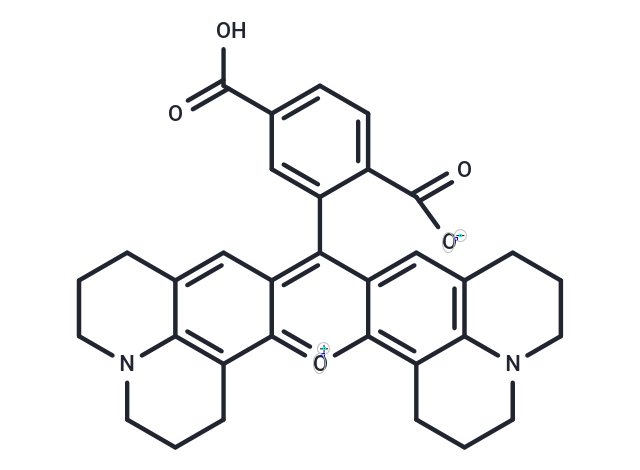Shopping Cart
Remove All Your shopping cart is currently empty
Your shopping cart is currently empty
6-ROX (6-Carboxy-X-rhodamine) is a fluorescent oligonucleotide marker and acts as an acceptor molecule coupled to 5-FAM as the donor in FRET imaging with excitation of 514nm and emission of 525nm.

| Pack Size | Price | USA Warehouse | Global Warehouse | Quantity |
|---|---|---|---|---|
| 2 mg | $29 | In Stock | In Stock | |
| 5 mg | $46 | In Stock | In Stock | |
| 10 mg | $77 | In Stock | In Stock | |
| 25 mg | $142 | In Stock | In Stock | |
| 50 mg | $238 | In Stock | In Stock | |
| 100 mg | $353 | In Stock | - | |
| 200 mg | $493 | In Stock | - | |
| 1 mL x 10 mM (in DMSO) | $54 | In Stock | In Stock |
| Description | 6-ROX (6-Carboxy-X-rhodamine) is a fluorescent oligonucleotide marker and acts as an acceptor molecule coupled to 5-FAM as the donor in FRET imaging with excitation of 514nm and emission of 525nm. |
| Animal Research | I. FRET Imaging Applications 6-ROX is commonly used in FRET experiments as a donor fluorescent molecule that binds to the acceptor 5-FAM. The concentration of 6-ROX is usually 1–10 μM. This setup is used to study molecular interactions such as protein-protein interactions, DNA hybridization, and cellular processes. 1. Material preparation: (1) 6-ROX-labeled oligonucleotides: 6-ROX is usually bound to the 5' end of the oligonucleotide or other biological molecules. (2) 5-FAM-labeled oligonucleotides (or other acceptor fluorescent molecules): The acceptor dye (such as 5-FAM) is bound to different parts of the oligonucleotide. (3) FRET buffer: Use an appropriate buffer (such as PBS) and add additives such as Mg²⁺ or NaCl to maintain optimal conditions for hybridization and FRET reactions. (4) Fluorescence spectrometer or FRET imaging system: Equipped with equipment capable of detecting excitation wavelength of 568 nm and corresponding emission wavelength (usually 512 nm for 5-FAM). 2. Steps: (1) Preparation: Conjugate 6-ROX to oligonucleotides or target molecules. (2) FRET experimental setup: Mix 6-ROX labeled oligonucleotides with 5-FAM labeled oligonucleotides, ensuring that they are in close enough distance for efficient energy transfer. (3) Excitation and emission detection: Under 568 nm excitation, detect the emission signal of 5-FAM (usually 512 nm). The FRET signal reflects the proximity between the donor (6-ROX) and acceptor (5-FAM) molecules. (4) Data analysis: Analyze the FRET efficiency, which is proportional to the interaction between the donor and acceptor molecules. The greater the energy transfer, the stronger the fluorescence signal of the acceptor. II. Gene expression and quantification: 6-ROX can also be used in real-time PCR experiments to monitor gene expression levels. The concentration of 6-ROX is 0.1–1 μM. It is often used in multiplex labeling experiments and can be used with other fluorescent probes to detect multiple targets in the same sample simultaneously. 1. Material preparation: (1) 6-ROX-labeled probe: used as a reporter molecule to monitor specific gene sequences during amplification. (2) PCR primers and template: use appropriate primers and templates to target specific gene sequences. (3) vReal-time PCR system: equipped with PCR equipment capable of detecting fluorescent signals of appropriate wavelengths. 2. Steps: (1) Probe design: design a highly specific 6-ROX-labeled probe that binds to the target gene sequence. (2) PCR amplification: in real-time PCR, the 6-ROX probe binds to the target DNA, emits fluorescence during amplification and is detected. (3) Quantification: quantify gene expression levels by measuring changes in fluorescence intensity. |
| Synonyms | 6-Carboxy-X-rhodamine |
| Molecular Weight | 534.6 |
| Formula | C33H30N2O5 |
| Cas No. | 194785-18-7 |
| Smiles | OC(=O)c1ccc(C([O-])=O)c(c1)-c1c2cc3CCCN4CCCc(c34)c2[o+]c2c3CCCN4CCCc(cc12)c34 |
| Relative Density. | no data available |
| Storage | keep away from direct sunlight | Powder: -20°C for 3 years | In solvent: -80°C for 1 year | Shipping with blue ice/Shipping at ambient temperature. | |||||||||||||||||||||||||
| Solubility Information | H2O: insoluble DMSO: 25 mg/mL (46.76 mM), Sonication is recommended. | |||||||||||||||||||||||||
| In Vivo Formulation | 10% DMSO+40% PEG300+5% Tween-80+45% Saline: 1 mg/mL (1.87 mM), Sonication is recommeded. Please add the solvents sequentially, clarifying the solution as much as possible before adding the next one. Dissolve by heating and/or sonication if necessary. Working solution is recommended to be prepared and used immediately. The formulation provided above is for reference purposes only. In vivo formulations may vary and should be modified based on specific experimental conditions. | |||||||||||||||||||||||||
Solution Preparation Table | ||||||||||||||||||||||||||
DMSO
| ||||||||||||||||||||||||||
| Size | Quantity | Unit Price | Amount | Operation |
|---|

Copyright © 2015-2026 TargetMol Chemicals Inc. All Rights Reserved.